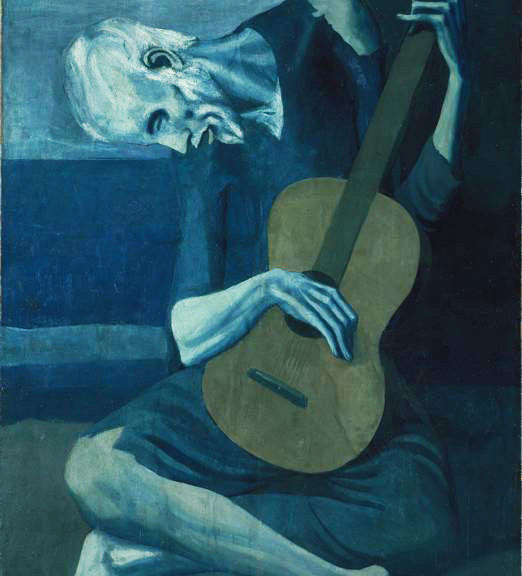
The Old Guitarist – 1905
Pablo PIcasso was a prominent painter, widely known for his fluxing and contrasting painting styles that kept aggressively changing over the course of his lifetime. “The Old Guitarist” was painted in 1904 with oil based paint on a canvas. It was painted during the artist’s “Blue Period” which was characterized by a heavy use of various tones of blue. In most paintings, this had a profound effect in the feelings they each depicted. In fact, most of the paintings that were created during that period are often perceived as somewhat “cold”, “melancholic”, and overall “depressing”. Furthermore, this painting was influenced greatly by the ideals of the expressionist movement. It was all about painting “how you see something” contrary to the past impressionist movement which was all about depicting an impression about “how you felt about a moment ‘en plein air’ “. That is exactly what one can see in “The Old Guitarist”; a detailed painting of an old, week, blind man hunched onto his guitar in the streets. Nevertheless, what makes this painting rather depressing is not the objective but rather the subjective. It is the lens through which Picasso depicted that situation what really makes this painting shocking to the public in general. It is that monochromatic selection of different tones of blue that create an emphasis on the lack of emotions thereof. Nevertheless, that monotony is broken by that one object that this man is holding… the guitar. All of those blue tones make this old man appear, spiritless, it is as if this man just passed away. This is why for me, the guitar represents a symbol for something that will live well after this man’s death. It is the music that he once created the one thing that will prosper well after this man’s death, this is the reason why this man is holding onto the guitar so strongly.
All of these elements unite to create a dull, shocking painting that reflect a situation through the perception of the artist. It is not an impression but a perception of reality. Furthermore, this change in ideals from impressionism to expressionism can be reflected in the difference of painting styles. Rather than depicting an impression about how something feels through the use of broken, dappled colors on a canvas, this painting uses monochromatism to represent a reality through a subjective mean.